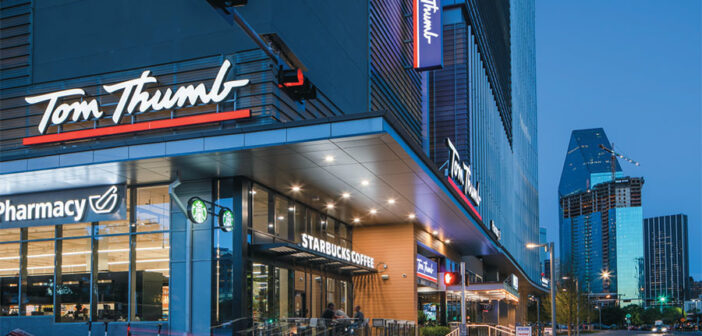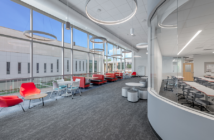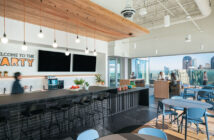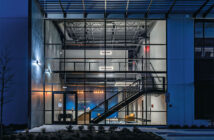

CLIENT SERVICES

SENIOR PROJECT MANAGER

PROJECT MANAGER
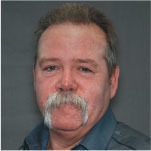
PROJECT SUPERINTENDENT

ASSISTANT PROJECT MANAGER

ASSISTANT SUPERINTENDENT
INTERVIEWEES: Jorden Dial, Client Services; Aaron Kuhl, Senior Project Manager; Robert Woys, Project Manager; Terry Boatwright, Project Superintendent; Joseph Traino, Assistant Project Manager; Ben Lawrence, Assistant Superintendent
PROJECT: Tom Thumb at The Union Finish-Out
PROJECT START DATE: February 2018
PROJECT COMPLETION: April 2019
ARCHITECT: HVA, Norsiah Daniels
OWNER: Tom Thumb, Randy Poydock
PROJECT DELIVERY METHOD: CSP
MAJOR TRADE PARTNERS: Berger HVAC, LLC; JBI Electrical Systems Inc.; 3D Mechanical Service Company Inc.; Sizelove Construction Inc.

PROJECT DESCRIPTION: Joeris General Contractors completed the 70,000+ SF interior finish-out of the Tom Thumb located in The Union. Tom Thumb is the development’s anchor retail store, located on the first floor of the 30-story mixed-use development. The full-service grocery store offers the traditional grocery products, including a bakery, deli, produce, floral department, and pharmacy, as well as a few unique services that make this a one-of-a-kind Tom Thumb. Residents of the building, commuters, and office workers located within the development can stop in and grab a quick coffee from an in-house Starbucks or a quick grab-and-go meal, eat at The Union Tap restaurant, order groceries and pick them up at the convenient Drive-up-and-Go station.
Q: THIS EDITION OF IN FOCUS IS FOCUSED ON SAFETY. WHAT PROACTIVE MEASURES DID THE TEAM EMPLOY TO KEEP EVERYONE SAFE DURING THE LIFE OF THE PROJECT?
A: Since we were working on another GC’s [DPR Construction] controlled site, we had the trade partners go through two safety orientations – both ours and DPR’s – so that they were familiar with the rules and regulations of the overall development, as well as Joeris’ specific work area.
Going into the project, we knew space was going to be limited, so we always put an extra focus on cleanliness and housekeeping. We also made a point early on when working with other GCs onsite to try to limit unnecessary traffic and keep things as efficient as possible, specifically being in Downtown Dallas and in such a tight space.
The area of the jobsite that we were working on had a lot of conditions, such as slab depressions, large penetrations, and some unfinished areas as the core-and-shell contractor was still completing their scope of work. With that, it took some extra coordination on our end to set up barricades, ramps, and all the necessary protocols to ensure everyone could navigate the site safely.
Q: HOW MANY PEOPLE WERE ONSITE AT THE PEAK OF THE PROJECT?
A: For Joeris’ area, we had around 200 workers at most, but the overall project had approximately 500 folks onsite at peak.
Q: WERE THERE ANY SPECIFIC TECHNOLOGICAL ADVANCEMENTS REQUESTED BY THE OWNER?
A: One of our goals is to always strive to exceed our owners’ expectations regarding technology, and that’s what we set out to do on this project. One thing is that when we take over a space from another contractor, we want to record all relevant information as soon as possible, so we immediately did a 360° laser scan to give us a map of the concrete throughout the building to make sure everything was in its proper place. Since there were incomplete aspects of the core-and-shell project when we mobilized, it was instrumental that we could bring this technology to the table to identify the actual footprint of the store and make sure everything was jiving. For the most part, everything checked out, but this was very key in managing expectations and identifying some small adjustments early on.
For example, we realized some of the elevated slab deck was encroaching on the space for the store’s coolers. We were able to identify this to the core-and-shell team, and they were able to cut that back to address the potential issue and avoid any issues later on.
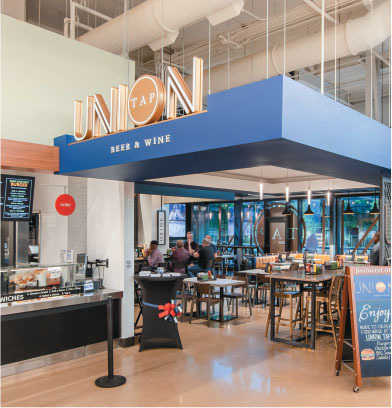
Q: WHAT CHALLENGES DID YOU FACE ON THE PROJECT?
A: Coordinating deliveries was a big one. We had a lot of materials coming in and out for our jobsite alone, but we had to additionally coordinate with all of the other deliveries for the whole surrounding project. It was a logistical challenge trying to get these 18-wheelers on a makeshift road into a small loading dock and making sure there was enough room to maneuver and unload safely. That was pretty tricky. Plus, we weren’t used to scheduling around a Jennifer Lopez concert or a hockey game.
On every project, there are some aspects that are beyond our control sometimes. For instance, we did have a large concrete pour for a 4-inch, integrallycolored topping slab to make a beautiful sales floor. We split the slab into 3 different sections, but a couple of the pours happened during hottest time of year and finished up around 3:00-4:00 p.m. in a high-traffic area of downtown Dallas. This caused some of the trucks to be delayed while we were still sitting inside waiting for more concrete, which did cause some discoloration. We took that as a challenge that we wanted to get ahead of with owner. We did test samples of what increased polish and shine would do to the slab and presented different options to the owner. We ended up taking out a few sections of concrete, but we knew we wanted to give our customer the best product possible.
Another major challenge was trying to determine where almost 400 MEP penetrations were going to go in a post-tensioned slab. We had to x-ray several areas of slab due to the thickness in order to identify where we could core for MEP penetrations. Due to technology and team coordination, we were able to do so without riddling the slab with unnecessary penetrations or hitting any post-tension cables. We did a lot of double checking to ensure that our penetrations weren’t going to land on any of the cables and put our guys in harm’s way, which helped us mitigate a huge potential safety risk.

Q: WHAT WAS MOST EXCITING ABOUT BUILDING THIS PROJECT?
A: It’s fun to build a place where people can shop in downtown Dallas – a place where I’ve now shopped myself – and to work with a client who’s working so hard to give their customers what they want. They really put a lot of thought into how they could provide maximum value, and they made a lot of changes in light of that. Overall, this was really a fun, cool project through and through and a one-of-a-kind store for this grocery chain. It was a truly unique experience.
Large projects have so much to do with the players involved, and there was a fantastic team from top to bottom that we worked with. There was a lot of great communication and coordination to make everything run smoothly, and that says a lot about the whole crew.

Q: HOW DID YOU MAINTAIN A SPIRIT OF COLLABORATION THROUGHOUT THE LIFE OF THE PROJECT?
A: Early on, Terry [the project superintendent]and Ben [the assistant superintendent]did a great job of making our name synonomous with getting things done. When the developer needed something done quickly and correctly, they knew they could call us. Every manager knew they could come to us for any help and ideas. We really tried hard to create the best place to work that we could.
We had weekly meetings with owners to discuss hot items, and detailed weekly trade partner meetings to discuss the week ahead, as well as a temporary office at the Taphouse with plenty of staff onsite. People knew we were always available when needed. We also held a daily huddle and built close relationships with our trade partners, which is something we do consistently from job to job. We always want to make sure we’re very approachable. And Joeris provides us with everything we need – with support like that, you can build anything.
The onsite Joeris team did a good job getting all of the contractors to interact and get along, as well as building a great relationship with DPR, the core-and-shell GC onsite. We created a team atmosphere for everyone on the project early on, which helped us get to the goal much easier. We also tried to not come in as a competitor to DPR, but just stayed focused on our piece of the puzzle. We knew who our client was, but we wanted to make sure we were also working closely with the developer, DPR, and DPR’s subcontractors.
Q: WHAT IS SOMETHING THAT SETS JOERIS APART FROM YOUR COMPETITION?
A: There are a lot of good general contractors in DFW, but Joeris’ advantage is our history of being fair and reasonable with trade partners, owners, and architects. This gives us a chance to work with the best of the best because our reputation precedes us. Our company was founded by a carpenter, so we know the value of the trade partner relationships. A big part of our culture is treating trade partners as we want to be treated and not as less important on the project. They’re just as or even more important in making sure the project is completed successfully.
Also, from an internal perspective, we don’t understaff our projects. And by doing so, that creates better balance for our employees and helps us serve our client and trade partners better. We’re able to get back to them in a more timely fashion and are able to better handle things that come up because of the way we staff our projects. We do our best to do so on every project, so we can serve in a service industry as best we can.

